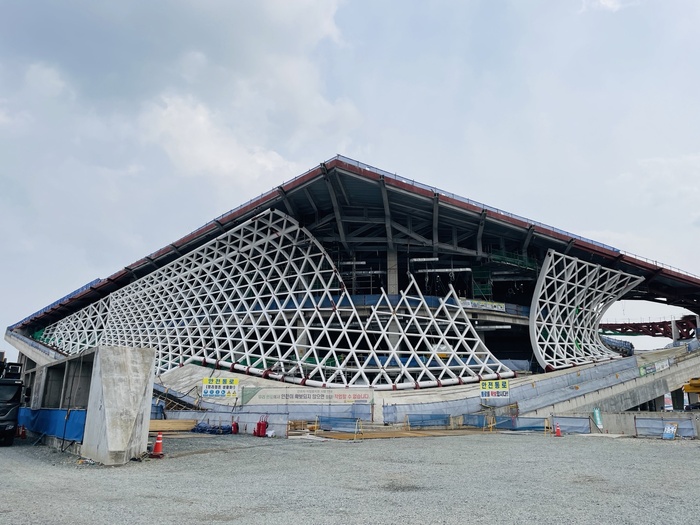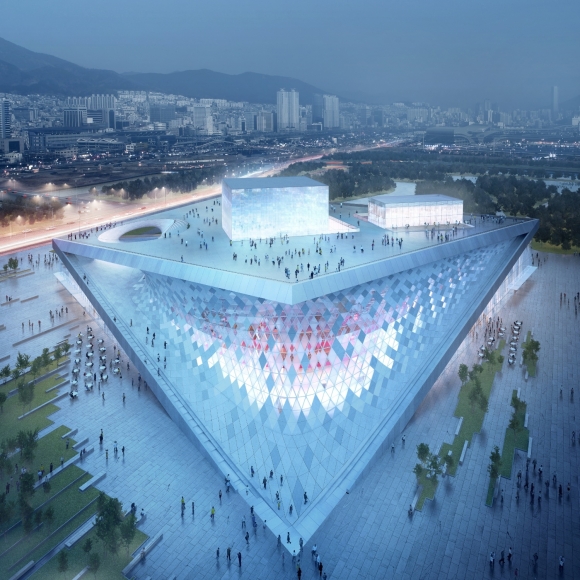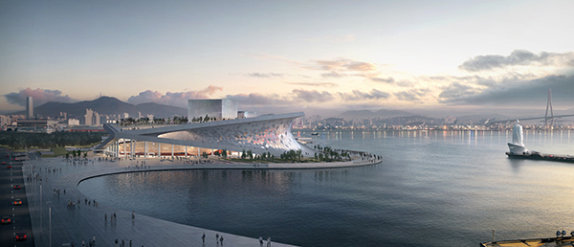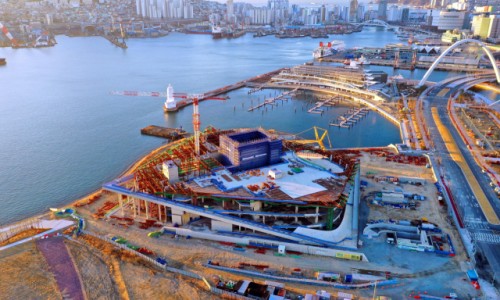Table of Contents
- Symbol of Dong-gu North Port Redevelopment, Construction of Busan Opera House Underway
- ‘A Shell Embracing a Pearl’ Shape… Irregular Facade Reflecting Global Architectural Design
- Causes of Construction Delays and Latest Upgrades… Creating Better Performance Environment
- ‘Walking Roof’ with Publicity and Openness, Expectations for a New Civic Cultural Space
- Conclusion: The Future of North Port Begins at Busan Opera House
- Frequently Asked Questions (FAQ)
Symbol of Dong-gu North Port Redevelopment, Construction of Busan Opera House Underway

The 'Busan Opera House' is currently under construction in the North Port redevelopment area of Choryang-dong, Dong-gu, Busan. This performance hall is planned to be completed by the end of 2026 and has entered the stage of exterior completion.
As the first large-scale classical performance hall introduced in Busan, the Busan Opera House is expected to become an important cultural facility, an icon of North Port, and a center for urban marine tourism.

According to Busan City, as of July 2024, the progress rate of the Busan Opera House is at 63%, indicating 99.7% completion of the planned schedule. Notably, the construction of the irregular facade structure, which symbolizes the opera house, is nearing completion, and the entire exterior is expected to be completed soon.
‘A Shell Embracing a Pearl’ Shape… Irregular Facade Reflecting Global Architectural Design

The Busan Opera House is a large-scale complex cultural facility consisting of 2 underground and 5 above-ground floors. It will feature an auditorium with 1,800 seats, a small theater with 300 seats, exhibition and rehearsal rooms, and various other facilities. The total area is about 29,500 square meters.
Particularly noteworthy is the unique appearance designed by the renowned Norwegian architectural firm ‘Snøhetta’. The facade is composed of curved surfaces, symbolizing a pearl inside an open shell facing the sea. This symbolizes Busan's identity as a maritime city and the characteristics of the North Port.
The irregular façade is being constructed using the twist construction method that requires complex construction. This method utilizes precision technology to connect assembled steel structures fabricated in factories into curved shapes. Currently, most of the structures are completed, and the work of attaching exterior materials such as glass and panels is expected to begin soon.
Through its unique design and construction methods, the Busan Opera House is expected to establish itself as a cultural icon of the city.
Causes of Construction Delays and Latest Upgrades… Creating Better Performance Environment

The Busan Opera House broke ground in 2018, but construction was halted once in 2023 due to controversy over the facade construction method. Subsequently, following the original plan, the twist construction method was selected, and construction resumed in May 2023. So far, construction has been proceeding smoothly.
Busan City plans to not only complete the construction but also to upgrade the internal finishing materials and equipment to the latest specifications. In particular, the finishing material of the auditorium will be changed from carbonized bamboo to oak, and the sound and lighting equipment will be newly replaced in line with modern trends.
This change is likely to increase the total construction cost beyond the current 311.7 billion won, and a budget adjustment may be necessary after 2025. Currently, 83.1 billion won has been allocated in the 2026 budget proposal.
‘Walking Roof’ with Publicity and Openness, Expectations for a New Civic Cultural Space

The Busan Opera House has a role beyond being a simple performance venue. It is designed as an open space that citizens can freely walk through, allowing easy access to the roof via 'cave' passages on the exterior walls of the building.
The roof is set to transform into a city walking path where people can enjoy the beautiful scenery of the North Port. This design is an excellent example of the integration of urban regeneration and public cultural facilities, and it is expected to become a space that Busan citizens and tourists can freely use.
Conclusion: The Future of North Port Begins at Busan Opera House

The Busan Opera House is not just a performance venue, but a symbol representing the North Port redevelopment, and has great potential to grow as a center for culture and tourism in Busan.
This project aims for completion by the end of 2026 and is scheduled to open in July 2027, which is expected to positively impact urban revitalization in Choryang-dong, Dong-gu.
Busan City and HJ Heavy Industries are working to ensure smooth construction while focusing on internal improvements to provide high-quality content. Much attention is focused on whether North Port can transform into a city where culture, industry, and tourism harmoniously coexist.
#BusanOperaHouse, #NorthPortRedevelopment, #Choryangdong, #BusanLandmark, #BusanPerformanceHall, #TwistConstructionMethod, #IrregularFacade, #Snøhetta, #BusanConcertHall, #NearBusanStation, #HJHeavyIndustries, #BusanCulturalSpace, #BusanPerformingArts, #BusanUrbanRegeneration, #BusanClassicalPerformanceHall, #BusanArchitecture, #BusanNightViewAttractions, #WalkingRoof, #BusanWalkingAttractions, #UrbanCulturalFacilities, #BusanGrandTheater, #BusanSmallTheater, #NorthPortCulturalBelt, #BusanFutureStrategy, #BusanCityAdministration, #PublicCulturalFacilities, #BusanConstructionStatus, #BusanArtSpace, #BusanPerformanceInformation, #BusanTouristAttractions
Frequently Asked Questions (FAQ)
Q. When will the Busan Opera House be completed and opened?
The Busan Opera House is scheduled to be completed by the end of 2026 and to open in July 2027.
The Busan Opera House under construction in the North Port redevelopment area of Choryang-dong, Busan, is planned to be completed by the end of 2026, and the official opening is scheduled for July 2027. This performance venue is expected to symbolize the North Port redevelopment and be a key point for regional cultural revitalization. Currently, the exterior construction is also nearing completion, accelerating the preparations for the opening.
Q. What are the main facilities and scale of the Busan Opera House?
The Busan Opera House is a large complex cultural facility consisting of an auditorium with 1,800 seats, a small theater with 300 seats, exhibition and rehearsal rooms.
This performance venue boasts 2 underground and 5 above-ground floors, covering an area of approximately 29,500 square meters. It is designed to enable various cultural and artistic performances and exhibitions, equipped with not only a 1,800-seat auditorium and a 300-seat small theater but also several exhibition and rehearsal rooms. This marks the introduction of the first large-scale classical performance venue in Busan, contributing to local cultural and artistic development.
Q. What are the characteristics of the exterior design of Busan Opera House?
It features an irregular facade in the form of ‘a shell embracing a pearl’, designed by a Norwegian architectural firm.
The exterior of the Busan Opera House was designed by the renowned Norwegian architectural firm Snøhetta, characterized by its irregular facade made of curved surfaces. This structure symbolizes the image of Busan as a maritime city and the characteristics of the North Port by portraying a pearl inside an open shell facing the sea. The facade is being crafted using a precise twist construction method, positioning it as a cultural icon of the city.
Q. What is the status of construction progress and the reasons for construction delays?
As of July 2024, the progress rate stands at 63%, with a construction halt in 2023 due to controversy over the facade construction method, followed by a resumption.
The Busan Opera House began construction in 2018 but temporarily suspended due to controversy regarding the facade construction method in 2023. After the twist construction method was finalized, construction resumed in May 2023 and is currently progressing smoothly. As of July 2024, the overall progress rate is at 63%, reflecting 99.7% advancement of the planned schedule. The external facade structure is nearing full completion.
Q. What are the details of the internal upgrades of the Busan Opera House and changes in budget?
The interior finishing materials and sound and lighting equipment are to be updated to the latest specifications, likely leading to an increase in construction costs.
Busan city plans to replace the existing carbonized bamboo finishing materials with oak, also modernizing the sound and lighting equipment in line with the latest trends. This internal upgrade could cause the total construction cost to increase beyond the previously estimated 311.7 billion won, indicating that a budget adjustment will be inevitable after 2025. Currently, 83.1 billion won has been budgeted for 2026.
Q. What is the 'walking roof' and what role does it play in the Busan Opera House?
The building's roof is open to the public, serving as a walking path and cultural space.
The Busan Opera House has been designed to allow citizens to freely access the roof via 'cave' passages on the building's exterior. This 'walking roof' is set to transform into an urban walking area where people can enjoy the scenery of the North Port. Emphasizing openness and accessibility, it is anticipated to become a new cultural space enjoyed by both Busan citizens and tourists.
Q. What significance does the Busan Opera House hold in the context of the Busan North Port redevelopment?
It serves as an icon of the North Port redevelopment and contributes to the cultural and tourism center for regional revitalization.
The Busan Opera House stands not merely as a performance venue but as an icon of the North Port redevelopment, destined to become a hub for Busan's culture and tourism. Scheduled for completion by the end of 2026 and opening in 2027, it is expected to positively impact urban revitalization in Choryang-dong. Busan City and construction company HJ Heavy Industries are focused on quality construction and improving content, leading the way for North Port to emerge as a city harmonizing culture, industry, and tourism.
